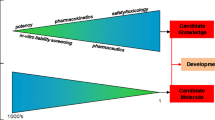Abstract
The Biopharmaceutics Classification System (BCS) is not only a useful tool for obtaining waivers for in-vivo bioequivalence studies but also for decision making in the discovery and early development of new drugs. Measurement of solubility and permeability in the discovery/development settings is described. These data can be utilized for the preliminary BCS classification of pipeline compounds. A decision tree is described in the prioritization of salt and polymorph screening studies prior to in vivo studies in animals. For BCS class 1 and 3 compounds, polymorphism is less likely to impact on bioavailability. The polymorph screening study may be postponed after animal studies. The BCS classification can also be used in the design of animal and human formulations. A BCS-based animal formulation development decision tree is presented. A compound is triaged based on a series of decision points into one of the five formulation strategies. Human formulation has different requirements than animal formulation. A comparison between animal and human formulation strategies is presented. In conclusion, for non-BCS 1 compounds, the right-first-time polymorph and formulation selection ensures consistent pharmacokinetic performance and avoids bridging BA/BE studies. It is in line with FDA’s initiative to reduce R&D cycle time through quality by design for pharmaceutical products.


Similar content being viewed by others
References
G. L. Amidon, H. Lennernas, V. P. Shah, and J. R. Crison. A theoretical basis for a biopharmaceutics drug classification: the correlation of in vitro drug product dissolution and in vivo bioavailability. Pharm. Res. 12:413–420 (1995).
W. Chi-Yuan, and L. Z. Benet. Predicting drug disposition via application of BCS: transport/absorption/elimination interplay and development of a biopharmaceutics drug disposition classification system. Pharm. Res. 22:11–23 (2005).
E. H. Kerns, and L. Di. Multivariate pharmaceutical profiling for drug discovery. Curr. Top. Med. Chem. 2:87–98 (2002).
Food and Drug Administration. Guidance for industry, waiver of in vivo bioavailability and bioequivalence studies for immediate-release solid oral dosage forms based on a biopharmaceutics classification system, Food and Drug Administration, Rockville, MD, 2000. Available at http://www.fda.gov/cder/guidance/index.htm.
World Health Organization. Proposal to waive in vivo bioequivalence requirements for WHO model list of essential medicines immediate-release, solid oral dosage forms. World Health Organization, Technical Report Series no. 937 (2006). Available at http://www.who.int/prequal/info_general/documents/TRS937/WHO_TRS_937__annex8_eng.pdf
M. S. Ku. An oral formulation decision tree based on the biopharmaceutical classification system for first in human clinical trials. Bull. Tech. Gattefosse. 99:89 (2006).
J. Baldoni. Role of BCS in drug development. AAPS/FDA workshop on BE, BCS and Beyond, May 21–23, 2007.
C. A. Lipiniski, F. Lombardo, B. W. Dominy, and P. J. Feeney. Experimental and computational approaches to estimate solubility and permeability in drug discovery and development settings. Adv. Drug Deliv. Rev. 23:3–25 (1997).
C. Bevan, and R. S. Lloyd. A high-throughput screening method for the determination of aqueous drug solubility using laser nephelometry in microtiter plates. Anal. Chem. 72:1781–1787 (2000).
A. Avdeef. High throughput measurements of solubility profiles. In B. Testa, H. van de Waterbeemd, G. Folkers, R. Guy (eds.) Pharmacokinetic Optimization in Drug Research: Biological, Physiological, and Computational Strategies, Verlag Helvetica Chimica Acta, Zurich, 2001, pp 305–326.
P. Artursson, K. Palm, and K. Luthman. Caco-2 monolayers in experimental and theoretical predictions of drug transport. Adv. Drug Deliv. Rev. 22:67–84 (1996).
P. V. Balimane, Y. Han, and S. Chong. Current industrial practices of assessing permeability and p-glycoprotein interaction. The AAPS Journal 8(1) Article 1, E1-E13 (2006).
J. T. Doluisio, N. F. Billups, L. W. Dittert, E. T. Sugita, and J. V. Swintosky. Drug absorption. I. An in situ rat gut technique yielding realistic absorption rates. J. Pharm. Sci. 58:1196–1200 (1969).
J. D. Irvine, L. Takahashi, K. Lockhart, J. Cheong, J. W. Tolan, H. E. Selick, and J. R. Grove. MDCK (Madin–Darby canine kidney) cells: a tool for membrane permeability screening. J. Pharm. Sci. 88:28–33 (1999).
S. Byrn et al. Pharmaceutical solids: a strategic approach to regulatory considerations. Pharm. Res. 12(7):945–954 (1995).
Guidance for industry, ANDAs: pharmaceutical solid polymorphism. Draft, Food and Drug Administration, Rockville, MD, 2007. Available at http://www.fda.gov/cder/guidance/7590fnl.pdf.
Author information
Authors and Affiliations
Corresponding author
Rights and permissions
About this article
Cite this article
Ku, M.S. Use of the Biopharmaceutical Classification System in Early Drug Development. AAPS J 10, 208–212 (2008). https://doi.org/10.1208/s12248-008-9020-0
Received:
Accepted:
Published:
Issue Date:
DOI: https://doi.org/10.1208/s12248-008-9020-0




